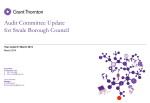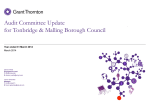Download The Audit Plan – template user guide
Transcript
Business Efficiency Board Update for Halton Borough Council Year ended 31March 2014 March 2014 Mike Thomas Director T 0161 214 6368 E [email protected] Liz Temple-Murray Manager T 0161 214 6370 E [email protected] John Padfield Executive T 0161 214 6378 E [email protected] © 2013 Grant Thornton UK LLP The contents of this report relate only to the matters which have come to our attention, which we believe need to be reported to you as part of our audit process. It is not a comprehensive record of all the relevant matters, which may be subject to change, and in particular we cannot be held responsible to you for reporting all of the risks which may affect your business or any weaknesses in your internal controls. This report has been prepared solely for your benefit and should not be quoted in whole or in part without our prior written consent. We do not accept any responsibility for any loss occasioned to any third party acting, or refraining from acting on the basis of the content of this report, as this report was not prepared for, nor intended for, any other purpose. . Contents Section Page Introduction 4 Progress at February 2014 5 Emerging issues and developments Local government guidance 7 Grant Thornton 14 Accounting and audit issues 17 © 2013 Grant Thornton UK LLP 3 Introduction This paper provides the Audit Committee with a report on progress in delivering our responsibilities as your external auditors. The paper also includes: • a summary of emerging national issues and developments that may be relevant to you as a local authority • includes a number of challenge questions in respect of these emerging issues which the Board may wish to consider. Members of the Business Efficiency Board can find further useful material on our website www.grant-thornton.co.uk, where we have a section dedicated to our work in the public sector. Here you can download copies of our publications – 'Reaping the Benefits': Welfare reform changes; 'Responding to the challenge: alternative delivery models in local government', '2016 tipping point?', 'Local Government Governance Review 2013', 'Towards a tipping point?', 'The migration of public services', 'The developing internal audit agenda', 'Preparing for the future', 'Surviving the storm: how resilient are local authorities?' If you would like further information on any items in this briefing, or would like to register with Grant Thornton to receive regular email updates on issues that are of interest to you, please contact either your Engagement Lead or Engagement Manager. Mike Thomas, Engagement Lead T 0161 214 6368 M 07880 456 173 E [email protected] Liz Temple-Murray, Engagement Manager M 07880 456 171 E [email protected] © 2013 Grant Thornton UK LLP 4 Progress at February 2014 Work Planned date Complete? Comments 2013-14 Accounts Audit Plan We are required to issue a detailed accounts audit plan to the Council setting out our proposed approach in order to give an opinion your 2013-14 financial statements. April 2014 In progress We will issue an Audit Plan that summarises the findings of our audit planning and our approach to the audit of the Council's accounts and Value for Money (VfM). Interim accounts audit Our interim fieldwork visit includes: • updating our review of the Council's control environment • updating our understanding of financial systems • review of Internal Audit reports on core financial systems • early work on emerging accounting issues • early substantive testing • developing our risk assessment for our Value for Money conclusion work. November 2013 to April 2014 In progress Our interim fieldwork is underway. Our findings will be included in the Audit Plan. 2013-14 final accounts audit Including: June to September Not started 2014 We will issue our Audit Findings (Report to those charged with governance) that will set out the findings of our accounts audit and VfM work for the consideration of those charged with governance. • audit of the 2013-14 financial statements • proposed opinion the Council's accounts • considering the impact of the final accounts audit work for our VFM Conclusion • Whole of Government Accounts © 2013 Grant Thornton UK LLP 5 Progress at February 2014 Work Value for Money (VfM) conclusion The scope of our work to inform the 2013/14 VfM conclusion comprises the consideration of two criteria: Planned date Complete? Comments January to September 2014 In progress February to November 2014 Not started February 2014 Yes On-going In Progress We are currently completing our risk assessment. • proper arrangements in place for securing financial resilience. • proper arrangements for challenging how it secures economy, efficiency and effectiveness. Other areas of work – certification of government grant claims under the Audit Commission regime. We will certify your 2013-14 government grant claims under the arrangements prescribed by the Audit Commission. Other areas of work – independent report on RGF claim You have asked us to provide a report on your Regional Growth Fund claim Other activity undertaken Other service lines within Grant Thornton UK LLP have undertaken VAT advice and Employee Solutions work for the Council. Details will be set out in the Audit Plan. © 2013 Grant Thornton UK LLP Unqualified report given 6 Charging plays a significant role in funding public services Local government guidance Income from charging In September, the Audit Commission published ‘Income from charging: Using data from the VFM Profiles, September 2013′. The briefing provides an analysis of councils' 2011/12 income from charging, totalling £10.2 billion, and the contribution it made to service spending. It looks at the trends for different types of councils across broad service areas. Key findings were: • charging in 2011/12 funded 9 per cent of single-tier and county councils’ overall service expenditure, and 20 per cent of district councils • nationally the total income from charging was less than half the amount raised through council tax in 2011/12, at the local level it exceeded council tax in one in three (32 per cent) district councils and one in five (21 per cent) London boroughs • there is great variation between councils in terms of the amount of income they generate from charges, the ratio of charging income to service spending, and the changes to these over recent years. The contribution of charging to spending in 2011/12 varied most for district councils, with 2 to 87 per cent being generated through charges. The Audit Commission chairman, Jeremy Newman, said 'There is no ‘one-size-fits-all’ formula for how councils set their local charging policies. We are providing information and tools for councils, and those who hold them to account, to help understand the important role that charging plays in councils’ strategic financial management. The fact that some bodies derive more income from charging than council tax is neither good nor bad, but highlights the significant role charging plays in funding public services, and reminds councillors and electors to carefully scrutinise the approaches councils are taking.' © 2013 Grant Thornton UK LLP 7 As business rate income grows, authorities will keep half of the growth Local government guidance Business rate collection In April 2013, the government introduced a business rates retention scheme. Local authorities as a whole will now be able to keep half of the business rates income they collect rather than paying it all into the national pool. As business rate income grows, authorities will keep half of the growth. In October, the Audit Commission published 'Business rates: using data from the VFM profiles October 2013'. This briefing has been drawn from the Commission's Value for Money (VFM) profiles and shows an analysis of English council's collection rates and costs of collecting business rates. The Audit Commission also highlights the following steps councils could take to maximise business rates: • supporting existing business to do well and attracting new businesses to the area • identifying and billing all business properties with a rateable value promptly • using discretionary relief in an effective way, targeting businesses most in need • preventing and tackling fraudulent claims for relief • improving collection rates • reducing collection costs. © 2013 Grant Thornton UK LLP 8 Councils must continue to adapt to meet the needs of local people Local government guidance Audit Commission research - Tough Times 2013 The Audit Commission’s latest research, http://www.audit-commission.gov.uk/wp-content/uploads/2013/11/Tough-Times-2013-CouncilsResponses-to-Financial-Challenges-w1.pdf shows that England’s councils have demonstrated a high degree of financial resilience over the last three years, despite a 20 per cent reduction in funding from government and a number of other financial challenges. However, with uncertainty ahead, the Commission says that councils must carry on adapting in order to fulfil their statutory duties and meet the needs of local people. The Audit Commission Chairman, Jeremy Newman said that with continuing financial challenges 'Councils must share what they have learnt from making savings and keep looking for new ways to deliver public services that rely less on funding from central government'. Key findings: The Audit Commission's research found that: • the three strategies most widely adopted by councils have been reducing staff numbers, securing service delivery efficiencies and reducing or restructuring the senior management team; • three in ten councils exhibited some form of financial stress in 2012/13 – exhibited by a mix of difficulties in delivering budgets and taking unplanned actions to keep finances on track; • auditors expressed concerns about the medium term prospects of one third of councils (36 per cent) © 2013 Grant Thornton UK LLP 9 Helping the High Street Local government guidance Support for UK high streets On December 6, 2013 the Communities Secretary set out a £1 billion package of support for UK high streets, the stated objectives being to: • support business and the private sector to have a greater stake in their high streets; • make it easier to diversify town centres; • ensure town centres remain accessible to visitors; • promote the use of technology to modernise town centres. Key elements of the strategy include: • a £1,000 discount in 2014/15 and 2015/16 for retail premises with a rateable value of up to £50,000 – including shops, pubs, café and restaurants; • capping the Retail Price Index (RPI) increase in bills to 2% in 2014/15; • extending the doubling of Small Business Rates relief to April 2015; • a reoccupation relief for 18 months with a 50% discount for new occupants of retail premises empty for a year or more; • assisting business cash flow by allowing businesses to pay their bills over 12 months (rather than 10) © 2013 Grant Thornton UK LLP 10 Austerity continued – further cuts in spending powers Local Government Guidance Final local government finance settlement 2014/15 On 5 February 2014 the government published the final local government finance settlement for 2014/15. This confirmed the proposals laid out in the provisional finance settlement. The government has proposed that any council tax increases made by billing or precepting authorities of 2 per cent or more will be subject to a referendum. This proposal needs to be accepted by Parliament. Excluding the Greater London Authority, the spending power for local authorities in England will fall by 2.9% in 2014/15 compared to 2013/14. As in previous years, councils will have their funding reduction capped at 6.9%. Indicative funding levels for 2015/16 have also been provided to assist local authorities with their medium term financial planning. The settlement will be finalised in February 2014. © 2013 Grant Thornton UK LLP 11 Joint Health and Social Care Plans to be in place by 4th April Local government guidance Better Care Fund In the June 2013 Spending Round the Government announced the prospective implementation of the Better Care Fund (formerly the integration transformation fund). The key aim is to ensure a transformation in integrated health and social care through local single pooled budget arrangements. Pooled budget arrangements are formally underpinned by Section 75 of the NHS Act 2006. Key issues • £3.8 billion for funding will be available from 2015/16, largely through a top slice of existing Clinical Commissioning Group (CCG) budgets; • Local Authorities with Adult Social Services, CCGs and NHS Trusts will need to collaborate through a single pooled budget arrangement to support the delivery of health and social care services in their designated local areas; • finalised joint health and social care plans must be in place setting out how pooled budgets will be spent – draft plans must be formally signed off by each statutory Health and Well Being Board and submitted to NHS England area teams by 14 February, with a 4 April 2014 deadline for submission of finalised plans © 2013 Grant Thornton UK LLP 12 Councils choosing their auditors one step closer Local government guidance Local Audit and Accountability Act The Local Audit and Accountability Act received Royal Assent on 30 January 2014. Key points: • the Act makes provision for the closure of the Audit Commission on 31 March 2015; • arrangements are being worked through to transfer residual Audit Commission responsibilities to new organisations; • there will be a new framework for local public audit due to start when the Commission's current contracts with audit suppliers end in 2016/17, or potentially 2019/20 if all the contracts are extended; • the National Audit Office will be responsible for the codes of audit practice and guidance, which set out the way in which auditors are to carry out their functions; • Local Authority's will take responsibilities for choosing their own external auditors; • recognised supervisory bodies (accountancy professional bodies) will register audit firms and auditors and will be required to have rules and practices in place that cover the eligibility of firms to be appointed as local auditors; • Local Authority's will be required to establish an auditor panel which must advise the authority on the maintenance of an independent relationship with the local auditor appointed to audit its accounts; • existing rights around inspection of documents, the right to make an objection at audit and for declaring an item of account unlawful are in line with current arrangements; • transparency measures give citizens the right to film and tweet from any local government body meeting. © 2013 Grant Thornton UK LLP 13 Procurement fraud in local government accounted for £876m this year Grant Thornton Potential for procurement fraud The Chancellor's Spending Round announcement last summer has forced authorities to make further cuts to their budgets and operate under tighter constraints. As Chris Clements, Head of Public Sector Forensics at Grant Thornton UK LLP, wrote in Local Government News, the National Fraud Authority estimates that in the wider public sector, the cost of fraud reached a staggering £19.9bn this year. Procurement fraud in local government accounted for £876m of this amount and therefore a properly functioning procurement process is key to mitigating much of this risk of loss. 'Helping ensure people are not in a position where they are tempted by an opportunistic gain is vital. Employees feeling undervalued – either financially or on account of other motivating factors – can breed an atmosphere of despondency which allows for procurement fraud. Sometimes all it takes is one exploratory incident by an individual to snowball into a culture wide acceptance of fraud, where employees not only rationalise the activity, but are spurred on by other actions.' © 2013 Grant Thornton UK LLP 14 79% of Councils anticipate Tipping Point soon Grant Thornton 2016 tipping point? Challenging the current This report http://www.grant-thornton.co.uk/Global/Publication_pdf/LG-Financial-Resilience-2016-tipping-point.pdf is the third in an annual series which assesses whether English local authorities have the arrangements in place to ensure their sustainable financial future. Local authorities have so far met the challenges of public sector budget reductions. However, some authorities are predicting reaching tipping point, when the pressure becomes acute and financial failure is a real risk. Based on our review of forty per cent of the sector, this report shows that seventy nine per cent of local authorities anticipate some form of tipping point in 2015/16 or 2016/17. Our report rates local authorities in four areas - key indicators of financial performance, strategic financial planning, financial governance and financial control. It also identifies a series of potential ‘tipping point scenarios’ such as local authorities no longer being able to meet statutory responsibilities to deliver a range of services. Our report also suggest some of the key priorities for local authorities in responding to the challenge of remaining financially sustainable. This includes a relentless focus on generating additional sources of revenue income, and improving efficiency through shared services, strategic partnerships and wider re-organisation. © 2013 Grant Thornton UK LLP 15 Alternative Delivery Models – are you making the most of them? Grant Thornton Alternative delivery models in local government This report: http://www.grant-thornton.co.uk/en/Publications/2014/Responding-to-the-challenge-alternative-delivery-models-in-localgovernment/ discusses the main alternative delivery models available to local government. These are based on our recent client survey and work with local government clients. It aims to assist others as they develop their options and implement innovation strategies. Local government has increased the variety and number of alternative delivery models it uses in recent years including contracts and partnerships with other public bodies and private sector organisations, as well as developing new public sector and non-public sector entities. With financial austerity set to continue, it is important that local authorities continue innovating, if they are to remain financially resilient and commission better quality services at reduced cost. This report is based on a brief client survey and work with local authority clients and: • Outlines the main alternative delivery models available to local authorities • Aims to assist other authorities as they develop their options and implement innovation strategies • Considers aspects of risk. © 2013 Grant Thornton UK LLP 16 How to streamline and simplify local authority financial statements Accounting and audit issues Simplifying and streamlining the presentation of local authority financial statements Both HM Treasury and CIPFA/LASAAC have recently consulted on how to streamline and simplify local authority financial statements. In our response, we set out our view that streamlining is a collaborative process involving standard setters, preparers of the accounts and auditors. This requires a much needed change in culture and attitude from the accounting and auditing profession as a whole. However, there is much that can be done now. In his October article in Room 151, the on-line local authority finance publication, Graham Liddell, Grant Thornton's National Technical Lead sets out the practical steps local authorities can take to: • learn the lessons from 2012/13 to improve the preparation and audit of the financial statements for future years • de-clutter their accounts using the previous year’s financial statements as the starting point Graham notes that Grant Thornton has been working with a range of local authorities to achieve these goals. One council audited by Grant Thornton succeeded in producing a set of financial statements in 2012/13 that were are only half the length of those for 2011/12 and were much easier to follow. © 2013 Grant Thornton UK LLP 17 The Local Authority Accounting Code of Practice for 2014/15 Accounting and audit issues Consultation on Local Authority Accounting Code of Practice for 2014/15 CIPFA/LASAAC's consultation on the Local Authority Accounting Code of Practice for 2014/15 closed in October. In our response we noted that the complexity of international financial reporting standards (IFRS) inevitably means that it is increasingly difficult to construct a Code that is comprehensive, of reasonable length and fit for purpose. We suggested that the Code of Practice follows the approach adopted by the Treasury in the Financial Reporting Manual under which bodies are required to follow the relevant accounting standard other than where there are specified formal adaptations or interpretations. This would result in a much shorter simpler Code with local authorities referring directly to the underlying standards themselves. This approach is consistent with that adopted in the NHS, where the accounting manuals do not seek to repeat text from accounting standards. In respect of the some of the other key consultation issues, our views were: • IFRS 13 - the Code should follow the principles of IFRS 13 as closely as possible. We regard it as important that there is a common application of fair value by all bodies preparing accounts under IFRS. • Infrastructure assets - we supported the adoption of IFRS based accounting for infrastructure assets. We recognise the practical difficulties in doing this and have offered to work with CIPFA/LASAAC and local authorities to help overcome these difficulties. • Schools - we emphasised the importance of addressing the accounting issues for schools as a matter of priority, particularly because this is an area for which the Whole of Government Accounts are currently qualified. © 2013 Grant Thornton UK LLP 18 Welfare reforms – what you think of it so far? Grant Thornton Reaping the benefits: first impressions of the impact of welfare reform. The potential scope of this topic is broad, so our report, focuses on the financial and managerial aspects of welfare reform. This involves: • Understanding the challenges currently facing local government and housing associations in regard to welfare reform and what organisations have been doing to meet this challenge in terms of strategy, projects and new processes. • Reporting on the early indications of effectiveness following the implementation of these measures and the impact of reform. • Providing early insight into challenges facing these organisations in the near future. We have pulled together information from a variety of sources, including our regular conversations across the local government and housing sectors and surveying local authorities and housing associations in England. We found that: • In general, organisations have been very active in engaging with stakeholders and putting in place appropriate governance arrangements and systems to implement specific reforms. A minority of organisations did not fully exploit all the options open to them in preparing for reform. • So far, the indication is that the impact of reform experienced by local authorities and partners has been managed effectively. This may be because the full impact has not yet been felt. Some worrying signs are emerging, including rising rental arrears, homelessness and reliance on food banks, which may be linked to the reforms. • Looking ahead, further reforms, such as the implementation of universal credit and the move to direct payments present significant uncertainties and challenges over the next few years. © 2013 Grant Thornton UK LLP 19 How do you recognise a PFI? Accounting and audit issues Private Finance Initiative Schemes and Service Concessions The Government financial reporting manual (FReM) and the Local Government CIPFA Code of Practice have now adopted IPSAS 32 (International public sector accounting standards) – Service Concession Arrangements. Previously under IAS 17 (International Accounting Standards – Leases ), the recognition point for an asset and a liability in the financial statements for such a scheme was at the commencement date of the contract, when the asset was handed over to the public sector and ready for use. Now under IPSAS 32, the recognition point is when: • it is probable that future economic benefits associated with the asset will flow to the organisation • the cost of the asset can be measured reliably. This suggests that some authorities may need to consider recognising service concession assets during the construction phase as assets under construction. In reaching a judgement as to whether to recognise an asset under construction, we would expect authorities to consider the extent to which they bear construction risk and whether they can get reliable information on the cost of construction from the operator. © 2013 Grant Thornton UK LLP 20 Keeping your PFI accounting up to date Accounting and audit issues Private Finance Initiative Schemes and Service Concessions Updating the accounting model during the operational phase Most authorities derive their accounting entries from an accounting model which, in turn, is derived from the operators costing model. The initial accounting model will have included a range of assumptions, such as inflationary increases. We would expect authorities to update the accounting model for actual information, such as inflationary increases and performance variations, during the contract. Disclosing the impact of inflation on commitments We expect authorities to disclose the impact of inflation on their service concession commitments. These commitments are affected by: • past inflation – previous price rises will be built into future payments • fluctuations in future inflation – this gives rise to uncertainties about future payments. Disclosing the fair value of the service concession liability Service concession liabilities are financial instruments. Therefore, we would expect authorities to disclose the fair value of the liability unless this is not materially different from the carrying value. In most cases we would expect the fair value for operational schemes to be higher than the carrying value. This is because once a scheme is operational, authorities have access to lower interest rates for refinancing. This is because the pre-construction interest rate reflects the risks associated with construction. © 2013 Grant Thornton UK LLP 21 Revaluing your assets – clarification of accounting guidance Accounting and audit issues Property, plant and equipment valuations The 2013/14 Code has clarified the requirements for valuing property, plant and equipment and now states explicitly that revaluations must be 'sufficiently regular to ensure that the carrying amount does not differ materially from that which would be determined using the fair value at the end of the reporting period.' This means that a local authority will need to satisfy itself that the value of assets in its balance sheet is not materially different from the amount that would be given by a full valuation carried out on 31 March 2014. This is likely to be a complex analysis which might include consideration of: • the condition of the authority's property portfolio at 31 March 2014 • the results of recent revaluations and what this might mean for the valuation of property that has not been recently valued • general information on market prices and building costs • the consideration of materiality in its widest sense - whether an issue would influence the view of a reader of the accounts. The Code also follows the wording in IAS 16 more closely in the requirements for valuing classes of assets: • items within a class of property, plant and equipment are to be revalued simultaneously to avoid selective revaluation of assets and the reporting of amounts in the financial statements that are a mixture of costs and values as at different dates • a class of assets may be revalued on a rolling basis provided revaluation of the class of assets is completed within a short period and provided the revaluations are kept up to date. There has been much debate on what is a short period and whether assets that have been defined as classes for valuation purposes should also be disclosed separately in the financial statements. These considerations are secondary to the requirement that the carrying value does not differ materially from the fair value. However, we would expect auditors to report to those charged with governance where, for a material asset class: • all assets within the class are not all valued in the same year • the class of asset is not disclosed separately in the property, plant and equipment note. © 2013 Grant Thornton UK LLP 22 Estimating the impact of business rate appeals Accounting and audit issues Business rate appeals provisions Local authorities are liable for successful appeals against business rates. They should, therefore, recognise a provision for their best estimate of the amount that businesses have been overcharged up to 31 March 2014. However, there are practical difficulties which mean that making a reliable estimate for the total amount that has been overcharged is challenging: • the appeals process is managed by the Valuation Office Agency (VOA) and so local authorities are reliant on the information provided to them by the VOA • some businesses may have been overcharged but not yet made an appeal. We would expect local authorities: • to work with the VOA to make sure that they have access to the information they need • where appeals have been made, to determine a methodology for estimating a provision and to apply this methodology consistently • where appeals have not been made: - to consider the extent to which a reliable estimate can be made (for example, in relation to major businesses) - to recognise a provision where a reliable estimate can be made - to disclose a contingent liability where a reliable estimate cannot be made - to provide a rationale to support their judgement that a reliable estimate cannot be made • to revisit the estimate with the latest information available immediately before the audit opinion is issued. © 2013 Grant Thornton UK LLP 23 Accounting for pensions Accounting and audit issues Accounting for and financing the local government pension scheme costs Accounting issues The 2013/14 Code follows amendments to IAS 19 and changes the accounting requirements for defined benefit pension liabilities such as those arising from the local government pension scheme (LGPS). This is a change in accounting policy and will apply retrospectively. The main changes we expect to see are: • a reallocation of amounts charged in the comprehensive income and expenditure statement (CIES) • more detailed disclosures. We do not expect changes to balance sheet items (the net pension liability and pension reserve balance). This means that whilst we would expect the CIES to be restated, a third balance sheet is not required. Actuaries should be providing local authorities with the information they need to prepare the financial statements, including restated comparatives. Financing issues The amount to be charged to the general fund in a financial year is the amount that is payable for that financial year as set out in the actuary's rates and adjustments certificate. Some local authorities are considering paying pension fund contributions early in exchange for a discount but not charging the general fund until later. Local authorities must be satisfied that the amounts charged to the general fund in a financial year are the amounts payable for that year. Where local authorities are considering making early payments, we would expect them to obtain legal advice (either internally or externally) to determine the amounts that are chargeable to the general fund. We would expect this to include consideration of: • the actuary's opinion on the amounts that are payable by the local authority into the pension fund • the agreement between the actuary and the local authority as to when these payments are to be made • the wording in the rates and adjustments certificate setting out when amounts are payable for each financial year. For example, if a local authority agrees to make a payment to the pension fund in a single year and proposes to charge this amount to the general fund over a three-year period, we would expect the rates and adjustments certificate to show, unambiguously, that the amount payable is spread over the three years. © 2013 Grant Thornton UK LLP 24 Changes to the public services pension scheme Accounting and audit issues Changes to the Local Government Pension Scheme The Public Service Pensions Bill received Royal Assent in April 2013, becoming the Public Service Pensions Act 2013 (‘the Act’). The Act makes provision for new public service pension schemes to be established in England, Wales & Scotland. Consequent regulations have been laid to introduce changes to the LGPS in England and Wales from 1st April 2014. (The regulations for the changes in Scotland have not yet been laid and will only impact from 1 April 2015). These introduce a number of changes including: • a change from a final salary scheme to a career average scheme • introduction of a 50/50 option whereby members can choose to reduce their contributions by 50% to receive 50% less benefit • calculation of contributions based on actual salary which could lead to some staff with irregular patterns of working moving between contribution rate bandings on a regular basis • changes in employee contribution rates and bandings • transitional protection for people retiring within 10 years of 1 April 2014 (further regulations are still awaited. The above changes have implications for all employers involved in the LGPS introducing required changes to their payroll systems to ensure pension contributions are calculated correctly. This has consequent implications for administering authorities to communicate with employers and consider how they will obtain assurance over the accuracy and completeness of contributions going forwards since the calculations are more complex going forwards and less predictable. In addition changes are also required to pension administration/payment systems as well as much more detailed processes around maintaining individual pension accounts for all members to ensure the correct payment of future pensions. The Act also requires changes to the governance arrangements although regulations for the LGPS have not yet been laid for these and the changes in governance arrangements are not expected to be implemented until 1 April 2015. © 2013 Grant Thornton UK LLP 25 Reporting the costs of public health Accounting and audit issues Changes to SeRCOP – new public health line SeRCOP for 2013/14 introduces a new cost of service line for 'Public health'. This has been introduced to reflect new responsibilities placed upon local authorities following restructuring in the NHS. We expect this new service line to be presented on the face of the CIES within cost of services. If there were material amounts relating to this service in 2013/14, we would expect comparative figures to be restated. © 2013 Grant Thornton UK LLP 26










































